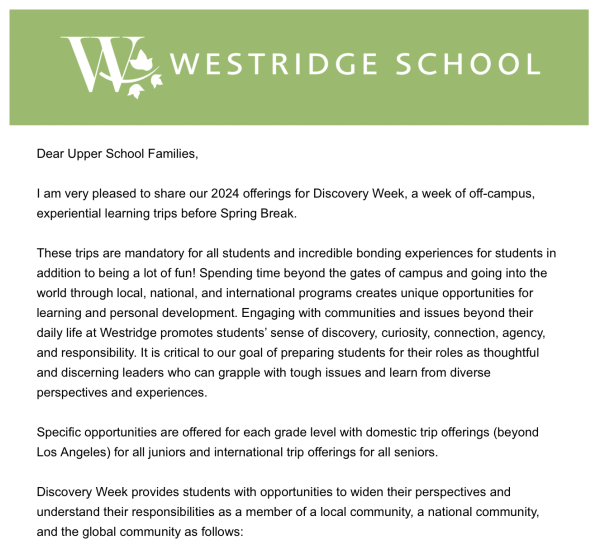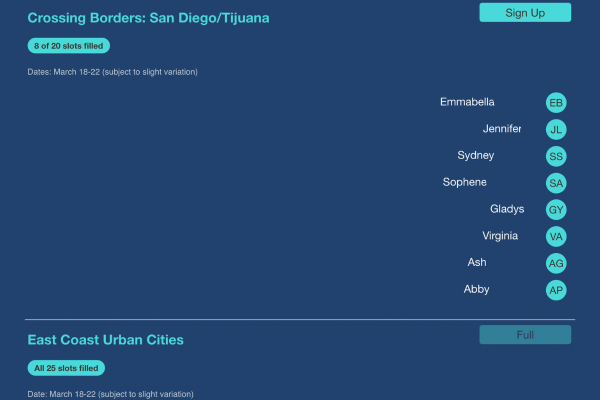On Monday, November 6, my Human Development class began our 70-minute session as usual—venting about recent stress and frustrations. Normally, we would talk about upcoming tests and quizzes and how tired we were, but on this day, the 16 of us were united on something else: Discovery Week. Frustrated and angry, Discovery Week 2024 was, to us, “pathetic,” “a joke,” and “a waste of money.” The list of negative phrases describing the week went on.
This discussion came less than four days after Director of Upper School Mr. Gary Baldwin sent an email detailing Discovery Week trip options for grade levels on Thursday, November 2. With only a few days in between trip announcements and registration, students had little time to ask questions or think about their choices.

For my grade, the juniors, trips included a Civil Rights trip to the South, a border trip to San Diego and Tijuana, an East Coast cities trip, and a Southwest Desert Art trip.
I will preface this by saying that the opportunities Discovery Week offers are privileges not everyone has, and I appreciate that Westridge is trying to provide its students with “a sense of discovery, curiosity, connection, agency, and responsibility,” to quote Mr. Baldwin in his Upper School-wide email. But as it stands right now, there are too many flaws within the design of Discovery Week to ignore.
Instead of giving students the freedom to choose how they want to explore local, national, and international communities, Westridge restricts students to a selection of unequal grade-level trips under the guise of equity.
After Discovery Week was redesigned post-pandemic to be a more equitable form of “Interim Week,” underclassmen now only travel locally within Los Angeles, 11th graders travel domestically, and 12th graders travel internationally. Furthermore, all trips within grade levels are priced the same—$500 for 9th and 10th graders, $2500 for 11th graders, and $3500 for 12th graders. The cost for the 11th grade increased by 25% from last year and the cost for 12th grade increased by a little over 16%.
Last year, I was mostly upset that I was required to pay $500 to visit my own city; but this year, the cost is only one of my concerns. Paying $2500 for a five-day trip to visit New York City, Washington D.C., and Charlottesville makes sense to me. You have to take into account flights, other transportation, food, hotels, and more. But only 25 students got this opportunity. 40 other students booked trips to the Southwest and the South, both also requiring flights and other transportation, probably worth close to $2500 as well.
The fourth 11th-grade option, Crossing Borders: San Diego/Tijuana, felt different. The drive from Westridge to San Diego is around 130 miles and can take 2–3 hours, depending on traffic. Unlike other trips requiring hours of flights, this trip can take less time than a drive to Big Bear Mountain, a location often used for the 9th grade retreat. My car has a mile-per-gallon rate of about 25 miles, meaning it would likely take about five gallons of gas to get to San Diego. Right now, my local gas station is advertising gas at $4.60/gallon, so it would cost me approximately $23 to get to San Diego by car. Meanwhile, flights to Albuquerque, Atlanta, and New York all cost north of $200, and sometimes hundreds more.
Don’t get me wrong—the content of the Crossing Borders trip sounds fascinating. From listening to immigrant activist voices to learning history about U.S.-Mexico foreign relations, there is a lot to take away from this trip. But slapping a $2500 price tag on it, compared to trips hundreds and thousands of miles away, is ridiculous and does not solve the issue of equity.
Making all trips $2500 may make them equal in price, but they certainly aren’t equal in students’ access to value and experience. How is it fair that one student gets to visit New York City and Washington D.C. while another is stuck visiting San Diego and Tijuana, against their will?
With the current pricing format, where all students within a grade pay the same fee, 11th-grade students are stuck paying $2500 no matter what. This proves problematic for two reasons. First, no trip can be exactly equal in value, leaving some students getting a better return on investment than others. Second, students do not have a say in how much they pay. Because allowing students to choose cheaper trips undermines Westridge’s current commitment to an equitable Discovery Week, I cannot opt into attending a 10th grade trip simply because it was cheaper.
The drama of the San Diego/Tijuana trip could have easily been lessened if it were priced differently, and maybe more students would be inclined to go, but because all trips were priced the same, San Diego/Tijuana presented itself as a ridiculous option compared to the other 11th-grade trips.
At the time of this being written, only eight students have signed up for the San Diego/Tijuana trip, out of the 20 slots available. I reached out to the eight students who signed up. Every single student but one told me that this was their last choice.

It is also important to note that some students are abstaining from signing up for the San Diego/Tijuana trip as a form of protest, despite students being asked to register for a trip, even if it is not their top choice.
When Mr. Baldwin first emailed about our trip options. I could see a lack of interest in a San Diego/Tijuana trip from a mile away, just based purely on the scope of the trip; and if the administration could not anticipate this, it says a lot about how no students or parents were consulted in determining this year’s trips. Trips are determined entirely by faculty, despite students being the ones funding these trips. If I have no say in my trip options, I should not be obliged to pay.
Another source of frustration which cuts across the grain of equity and access is the way students were asked to sign up. Aside from the free-for-all nature of the sign up, many students experienced tech problems while trying to sign up on SignUpGenius, the platform used for registration. Just like her classmates who woke up early, Jennifer L. ’25 was right on time for registration, but she was stuck registering for the San Diego/Tijuana trip because of a slow computer and ad pop-up.
Additionally, many students—including myself—noticed that access to the SignUpGenius form was granted at 6:59, one minute before the scheduled open time. Although it was less than 60 seconds before the time students were told, half of the slots for the East Coast Urban Cities trip filled within a minute, making each and every second valuable. Registration ended feeling like a bloodbath.
The only recourse for those students is if another drops out. Ms. Brittany Coker, Dean of Upper School Student Activities, wrote in her email, “After November 15th, when registration closes, if you are still not on your preferred trip, please send an email…so you can be added to the waitlist for your preferred choice trip.” At this point in time, a spot on a waitlist guarantees nothing.
While students who got their top choice of trip had a say in which trip they chose, not everyone had that luxury. From SignUpGenius struggles to slow WiFi to the form opening early, a 7 a.m. digital sign-up sheet was a disappointing way to determine trip attendees.
Finally, I find it frustrating that I do not have a choice to skip Discovery Week entirely. Someone in my Human Development class said, “They do that because no one would go if it was not required.” I don’t know that every student wouldn’t go, but I know for a fact that I wouldn’t.
I’m fortunate in that I did get my first choice, and I have had opportunities to travel nationally and internationally, but I would still choose to invest that kind of money differently.
For the same $2500, I could enjoy a low-level trip to Europe. Prices change depending on dates but from Saturday, March 16 to Saturday, March 23, I could get a full-week trip to London for around a $600 plane ticket. I would then have around $1900 to spend on cheap hotels or even hostels and food. While it would not be the most luxurious trip, I would still rather do that than pay $2500 to go on a trip to New Mexico, and I don’t know anyone who would or could make the argument that a trip to San Diego and Tijuana should cost $2500—except Westridge.
While I can get behind the value of the Southwest art trip in comparison to the San Diego and Tijuana trip, I still think the price is disappointing.
Last year, plenty of students and parents expressed their frustrations regarding Discovery Week. I was hopeful that their feedback would make a difference in our experience in the following year, but I was mistaken. I was frustrated with Discovery Week last year, and I’m frustrated with it again this year. Westridge will have one more opportunity to get it right next year, and that starts by giving students a real choice.




























![Dr. Zanita Kelly, Director of Lower and Middle School, pictured above, and the rest of Westridge Administration were instrumental to providing Westridge faculty and staff the support they needed after the Eaton fire. "[Teachers] are part of the community," said Dr. Kelly. "Just like our families and students."](https://westridgespyglass.org/wp-content/uploads/2025/03/dr.-kellyyy-1-e1748143600809.png)

























ll • Dec 11, 2023 at 3:41 pm
I also hate how they make it mandatory. It feels like they’re stealing souls with the prices and pointing a gun to your head. It’s actually mind boggling how only the faculty gets a say.
isla radisich • Nov 13, 2023 at 2:05 pm
i agree completely ella!! great article!